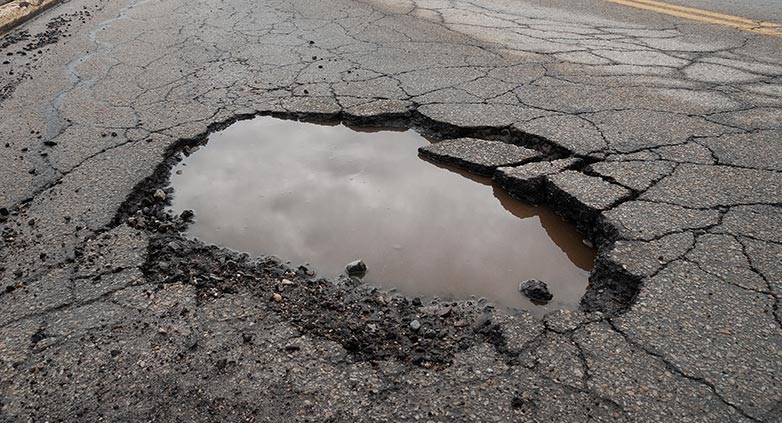What Causes Potholes – The Ultimate Road Mystery Explained
Discover the reasons behind potholes, common yet hazardous road issues. Understanding their causes is key to effective prevention and repair
Potholes form primarily due to water seeping into the pavement and weakening the soil beneath. This issue is exacerbated by the freeze-thaw cycle in colder climates. Heavy traffic contributes to the wear and tear, accelerating the formation of potholes. Over time, as asphalt ages, it becomes more susceptible to cracking, allowing more water infiltration and subsequent pothole development.
Explore in-depth insights on pothole formation, prevention strategies, and repair techniques to maintain safe and smooth roadways.
What are potholes?
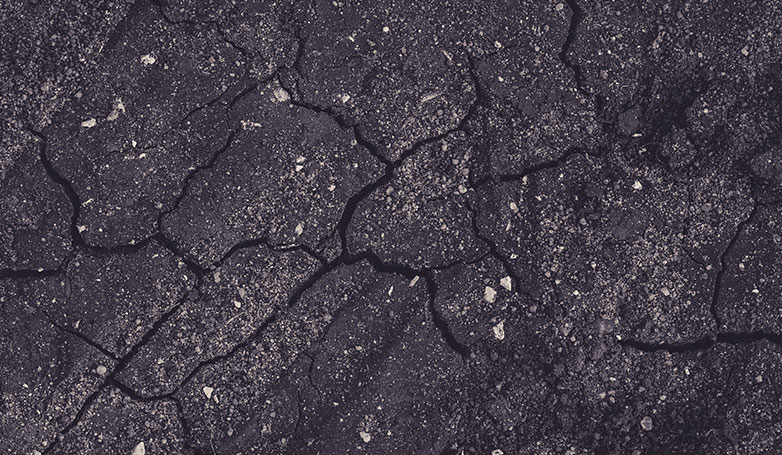
Potholes are sections of road surface that have developed cracks, worn away, and ultimately created a hole. In fact, potholes begin as tiny cracks and can expand from just a few inches deep and wide to be anywhere (few feet wide and many inches deep) if they are not repaired on time.
Potholes are tiny, bowl-shaped pavement surface depressions that penetrate the Hot Mix Asphalt layer down to the base course. Generally, they have sharp/rough edges and vertical sides close to the top of the hole.
Potholes show up on all roads, irrespective of the region. Your pavements can not avoid potholes even if you reside in a region where it is always warm. Water has a way of eroding road surfaces under any climatic conditions. Even without freezing and thawing cycles, water can still penetrate through the pavement’s surface to its underneath, creating divots by weakening the materials, including loose gravel, forming the roadbed.
What causes potholes?
Potholes form naturally due to many elemental forces in action. Typically, potholes develop when moisture permeates a paved surface or when the groundwater beneath the pavement penetrates the paved surface. The heating up and cooling down of water triggers the surface to expand and contract, causing weakness to the pavement with the added pressure.
Also, when a pavement surface already has a weak spot, as a car or truck moves over it, the vehicle’s weight causes the surface to disintegrate further, leaving potholes to form.
The seasonal freezing and thawing cycle experienced by most countries every year is one of the main causes of potholes.
The Impact of Vehicles and Climate on Pothole Formation
Water often enters under the pavement through the pavement surface; as the groundwater expands and contracts, it causes potholes to form on the pavement. You should think of when making ice cubes – a water-filled tray is placed in the freezer, and when the tray is removed from the freezer, you will observe that the water has expanded. This similar effect occurs when water penetrates the ground beneath the pavement.
If it tends to freeze, it will occupy more space beneath the pavement, leading to expansion, bending, and cracking of the pavement, which weakens the pavement material. After then, when the frozen water melts, the pavement will contract, leaving voids or gaps in the surface beneath the pavement, where water can enter and get trapped. As the water freezes and thaws repeatedly, the pavement will wear out and begin cracking.
When the weight of cars and trucks moves over the driveway’s weak area, it weakens pieces of the driveway material, causing the material to be displaced or deteriorate from the weight, which creates the pothole.
What time of the year are potholes most likely to occur?
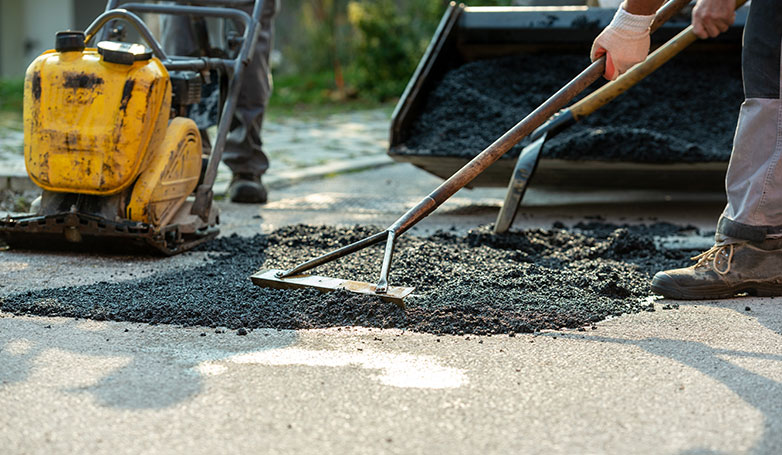
Are you always curious to know the season of potholes? Sometimes, it seems like it is all the time, but it’s actually not.
Potholes often appear in late winter and early spring due to changing temperatures. The frequent freeze/thaw cycles of melting snow, coupled with spring rain, erodes the pavement, and that is what causes potholes and cracks formation.
Winter is the peak period for asphalt pavement damage, particularly in cases of frequent melting and freezing. This can rapidly cause the occurrence of eggshell cracks or potholes.
Also, we have noticed lots of potholes form during the early spring because that is when we get daytime temperatures above freezing due to the longer daylight hours and nighttime temperatures below freezing.
This change of temperature leads to many freeze/thaw cycles that cause potholes. Therefore, early spring can also be regarded as the season where potholes most likely occur.
How are potholes repaired?
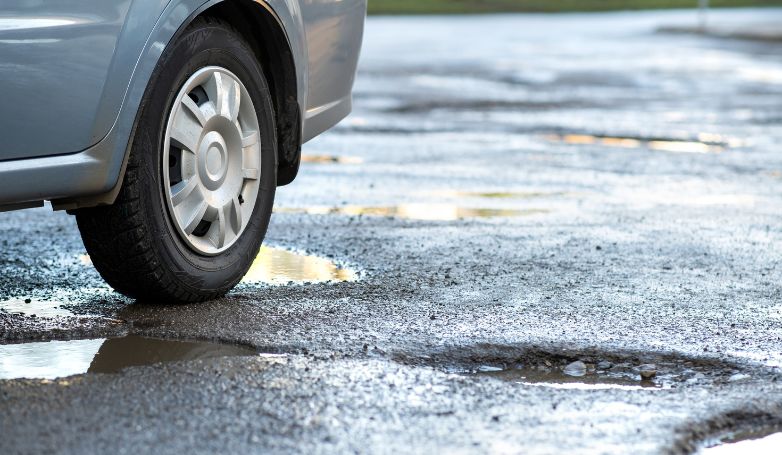
If your pavement has already developed potholes and you are curious to know how to get it fixed, the following steps show how to repair potholes on pavement effectively;
Get the pothole cleaned
To initiate an effective pothole repair, meticulous cleaning is paramount. This involves removing dirt, debris, and any loose pavement fragments from the pothole. This not only ensures a clean canvas for the repair but also prevents potential weaknesses by promoting optimal adhesion of the new asphalt.
Heat the pothole
The heating phase is a critical preparatory step in the pothole repair process. By applying heat to the pothole, excess moisture is evaporated, creating a dry foundation for the new asphalt. Simultaneously, the heating process softens the surrounding pavement, facilitating better integration of the fresh asphalt. This step also allows for reshaping of the pothole and extraction or rejuvenation of existing asphalt, contributing to a more robust and enduring repair.
Apply the new asphalt
Utilizing a hot asphalt mix is key to a successful pothole repair. The application involves filling the pothole with the hot mix, followed by thorough compaction. This compaction not only minimizes water penetration, a primary cause of potholes, but also establishes strong bonds between the new and old asphalt pavement. The result is a repair that boasts improved structural integrity and resilience.
Give the new asphalt time to cool
Post-application, allowing the new asphalt to cool is vital for the repair to solidify. During this cooling period, any remaining debris is cleared from the repaired area. The significance of this step lies in creating a smooth, durable surface that can withstand the stresses of vehicular traffic. In many cases, this cooling process is expedited, enabling the road to be reopened for immediate use.
Quality Check and Maintenance
Conducting a thorough inspection after the repair is crucial to ensuring its quality and longevity. This involves assessing the compaction of the new asphalt, verifying its resistance to water penetration, and confirming the structural soundness of the patched area. Additionally, emphasizing regular maintenance practices, such as routine inspections and prompt repairs, becomes integral in preventing the recurrence of potholes and extending the overall lifespan of the pavement.
How can the formation of potholes be avoided?
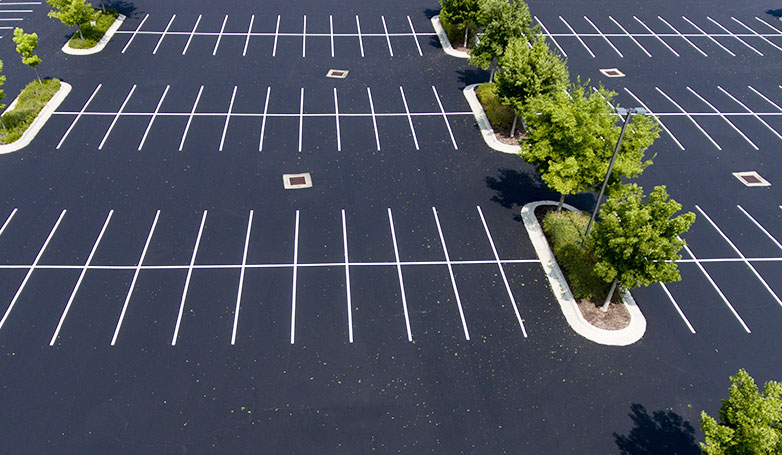
Here are the ways you can avoid the formation of potholes:
- Cracks filling
- Regular seal coating
- Do not allow standing water.
Constructing your pavement correctly in the first place is one of the most critical measures in pothole prevention. A well-laid driveway has a remarkable ability to stand against damage.
Crack filling
Timely addressing of cracks is paramount in preventing potholes. Once cracks appear in your driveway or pavement, swift action is needed to fill them. Unattended cracks can provide an entry point for water and other contaminants, accelerating pavement deterioration and increasing the risk of pothole formation.
Regular seal coating
It’s a smart idea to have your driveway and other pavement seal coated every few years. This is a preventive intervention intended to keep harm at a distance. Sealcoating also ensures that tiny cracks are filled in. While you might not be able to see these very tiny breaks in the pavement surface, They are a concern since they are likely to get bigger over time.
Do not allow standing water
When rainwater runs through a driveway or other pavement, it poses a serious threat to the surface. It is bad enough when water remains on the pavement’s surface. Standing water causes the pavement’s protective layer to wear away and speeds up degradation. This and some other external factors are what causes potholes to form. But water is the main cause.
How to avoid potholes and prevent vehicle damage

- Always concentrate while driving to scan the road so as to spot what is in front of you.
- Ensure you keep a safe following distance to know when the driver in front of you react to seeing a pothole so you can be able to brake safely and have a clear view of what is in your front
- Avoid overspeeding when driving on a road that appears rough. Consider seeking an alternative route if the road is poor.
- Pay attention to water. Water from a close snowbank and rain can be absorbed by large potholes, making it impossible to know how big the pothole really is.
- Avoid swerving as it could put you in more danger doing so. Dodging may make you veer into an oncoming lane of traffic. Instead, apply the brake gently when you see a pothole and safely avoid it.
FAQs about what causes potholes
Explore the frequently asked questions (FAQs) below to gain insights into how potholes form, ways to prevent their occurrence, and specific factors contributing to their presence on dirt roads.
How do you stop potholes from forming?
The key to preventing potholes involves proactive maintenance measures. Timely filling of cracks, regular seal coating, and addressing drainage issues are effective ways to stop potholes from forming. These preventative actions help maintain the integrity of the pavement and reduce the likelihood of pothole development.
What causes potholes on dirt roads?
Potholes on dirt roads are primarily caused by the impact of weather conditions, especially water. When rainwater seeps into the soil beneath the dirt road, it softens the ground, making it more susceptible to erosion. As vehicles traverse the road, the weakened soil gives way, leading to the formation of potholes. Lack of proper drainage exacerbates this process.
Should potholes always be avoided?
Ideally, yes. Potholes pose risks to both vehicles and pedestrians, and their presence indicates pavement degradation. While avoiding potholes is advisable, it’s equally crucial to address the root causes—such as cracks, water damage, and poor drainage—to prevent their formation in the first place. Regular maintenance and prompt repairs contribute to safer and more durable road surfaces.
Conclusion
Potholes create a terrible experience for drivers as they drive through the driveway surface. They also pose a severe threat to the pavement structure, reducing its longevity. Hence, it is vital to have even the tiniest cracks on your driveway fixed as soon as you notice it to avoid expanding to a giant hole.
One of the best ways to avoid potholes is to take care of your pavement properly. You can seek professional advice to guide you on how to best prevent the formation of potholes on your driveway, even in the winter and spring seasons.

